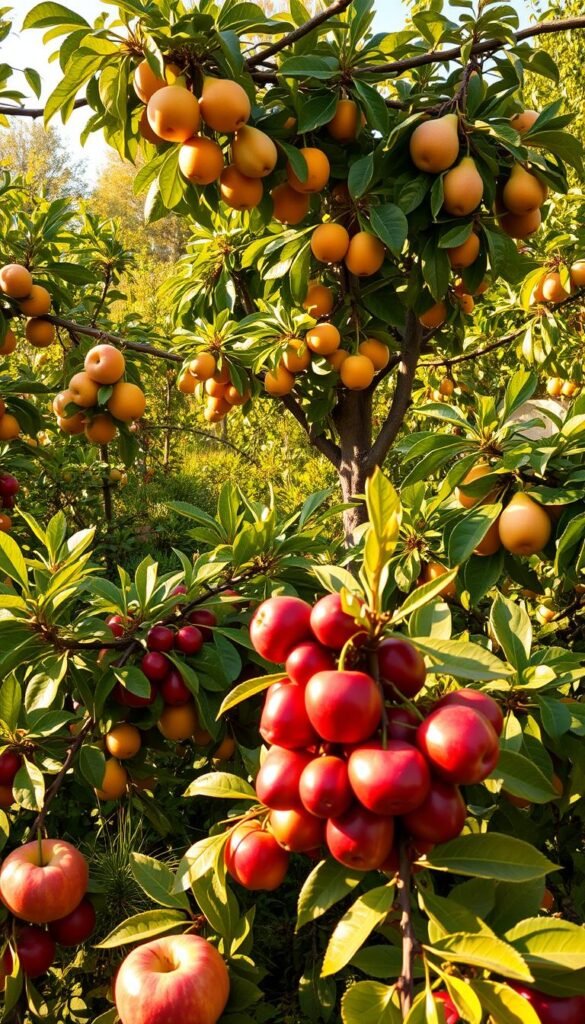Dreaming of plucking juicy treats from your own yard? The secret to success lies in choosing plants that thrive in your local weather patterns. Whether you’re battling frosty winters or scorching summers, there’s a world of delicious options waiting to transform your space.
Cold regions offer surprising variety—think crisp apples, sweet pears, or tangy berries that laugh at freezing temps. Warmer areas? Tropical favorites like citrus or figs bask in the heat. The trick is knowing which types match your exact growing conditions.
Smart growers use nature’s blueprint. By selecting species adapted to your area, you’ll spend less time battling the elements and more time enjoying harvests. Ever tried Cornelian cherries or beach plums? These uncommon gems often outshine supermarket staples in both flavor and hardiness.
Your local temperature swings, frost dates, and seasonal changes aren’t obstacles—they’re your roadmap. Pair this knowledge with permaculture strategies, and you’ll create a low-maintenance edible landscape that keeps giving year after year.
Understanding Your USDA Hardiness Zone
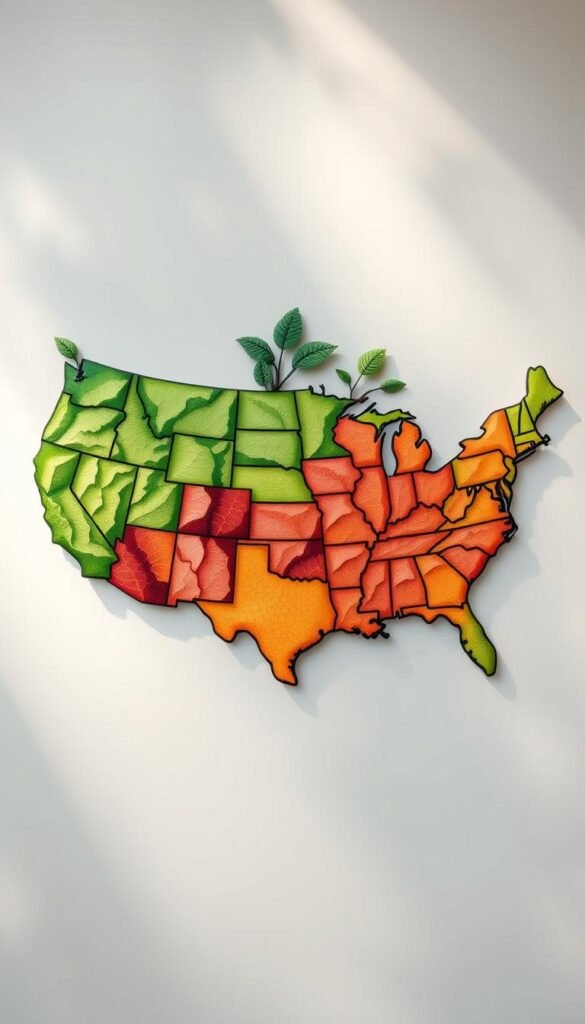
Unlocking your growing success begins with a simple ZIP code search. The USDA’s color-coded map splits North America into 13 regions, each representing a 10°F winter temperature difference. This system acts like a survival guide for plants, showing which species can handle your area’s coldest nights.
Mapping Your Zone
Type your ZIP into the USDA’s online tool, and you’ll instantly see your zone number. Zone 1 endures -60°F Arctic chills, while Zone 13 basks in 60°F tropical warmth. Most gardeners fall between Zones 3-9, where smart choices make all the difference.
Interpreting Temperature Ranges
Zone 3 growers face unique challenges—think -40°F winters that demand ultra-tough plants like cold-hardy varieties. Neighboring Zone 4 offers relief, with milder lows allowing more options. Pro tip: Your yard might have microclimates—south-facing walls or low spots—that shift conditions by half a zone.
Why does this matter? Fruit tree buds can die if temps swing wildly after spring thaw. Knowing your zone’s patterns helps you pick plants that laugh at weather surprises rather than becoming expensive compost.
Know Your Local Microclimate for Fruit Success
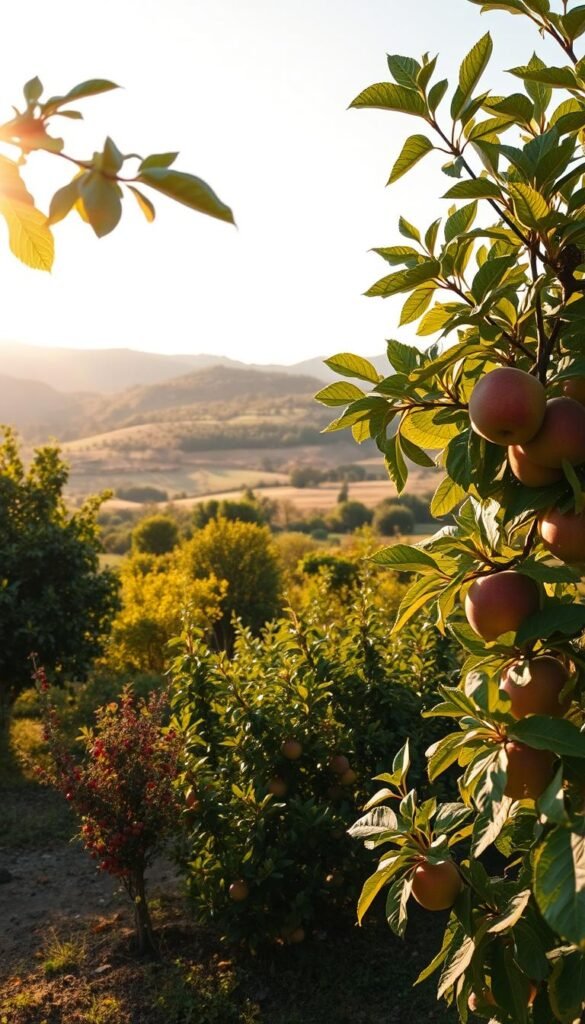
Your backyard holds hidden growing zones that can make or break your harvest. Microclimates—small areas with unique weather patterns—act like secret gardens within your property. These pockets of warmth or chill let you push beyond your zone’s limits when you know where to look.
Identifying Warm Spots and Frost Pockets
South-facing walls become solar ovens, radiating heat long after sunset. Plant figs or citrus here in cooler regions—they’ll bask in reflected warmth. But watch low ground where cold air pools like invisible water. These frost traps can be 5-10°F colder than nearby slopes, killing tender buds overnight.
Walk your land after sunrise on a calm winter day. See where ice lingers? That’s a frost pocket. Notice bare patches where snow melts first? Those are your warm zones. Even a 3-foot elevation change creates air drainage that protects plants.
Use structures strategically. A fence blocks icy winds, creating a sheltered area for peaches. Stone paths store daytime heat, warming soil for early-spring berries. By mapping these variations, you might grow persimmons in Zone 5 or cherries in Zone 9—defying expectations through smart placement.
Factors Impacting Fruit Tree Growth in Different Climates
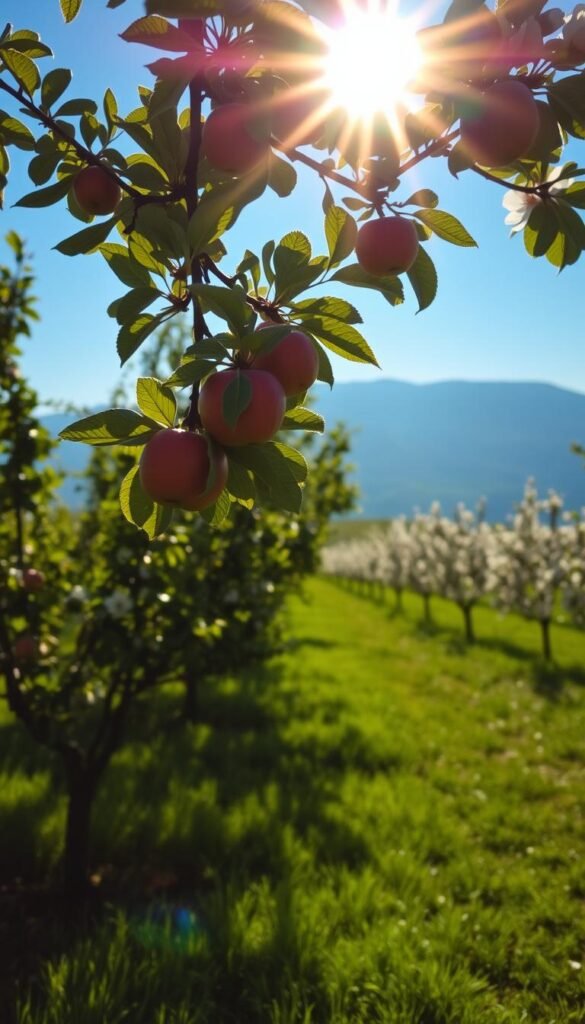
Your trees’ performance hinges on nature’s hidden clocks. Most varieties require chill hours—winter temps between 32-45°F—to reset their biological timers. Without this cold nap, blossoms might never wake up properly. “It’s like setting an alarm clock for spring,” one orchardist notes. “Miss the required chill, and your harvest sleeps through the season.”
Late frosts become thieves in warmer months. Tender blooms can freeze solid overnight, wiping out entire crops. Smart growers track their area’s last frost dates like hawk-eyed meteorologists. Row covers or wind machines become essential tools when mercury dips unexpectedly.
Roots tell their own weather story. Soggy soil drowns oxygen supplies during wet springs, while summer heat bakes earth into concrete. Mulch acts as nature’s thermostat—cooling roots in scorching zones and insulating them where winters bite hard.
Sun-scorched fruits? They’re not just summer problems. Reflective ground covers and strategic shading protect delicate skins in high-heat regions. Meanwhile, coastal growers battle salty winds that crisp leaves like potato chips. Every climate serves unique challenges—but matching varieties to your local drama creates thriving edible landscapes.
Fruit Garden Ideas for Every Climate: Cold-Hardy vs. Warm-Climate Species
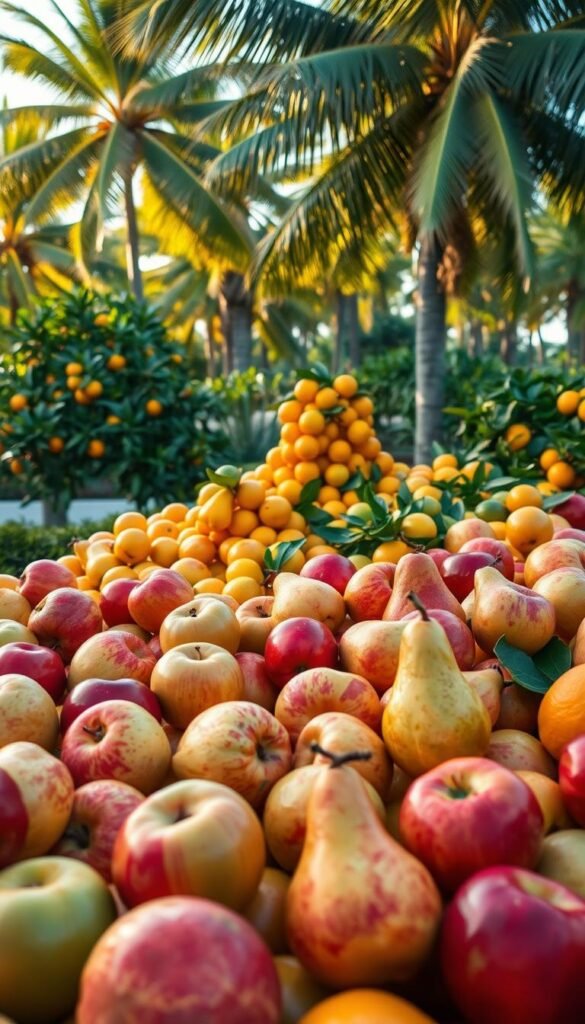
Transform your backyard into a resilient food source by matching plants to your region’s weather personality. The right picks deliver bumper crops with minimal fuss, whether you’re facing snowdrifts or heatwaves.
Why Tough Northern Varieties Shine
Cold-hardy champions like Aronia berries laugh at -27°F winters while packing more antioxidants than blueberries. These workhorses need little coddling – fewer sprays, less watering, and minimal winter wraps. Ever tried Cornelian cherry jam? Its tart-sweet flavor beats store-bought preserves hands-down.
Sun-Loving Southern Specialties
Warm-climate trees offer nonstop production. A single Meyer lemon can yield fruits year-round in Zone 9, while fig varieties produce two juicy harvests. Tropical gems like guava bring vacation vibes to your patio, thriving where frost never visits.
Hybrid breakthroughs blur climate lines. New apricot varieties now handle Zone 4 chills, while cold-tolerant citrus withstands brief freezes. Your local nursery often stocks these climate-crossing superstars – just ask!
Cold-Hardy Fruit Trees for Northern Regions
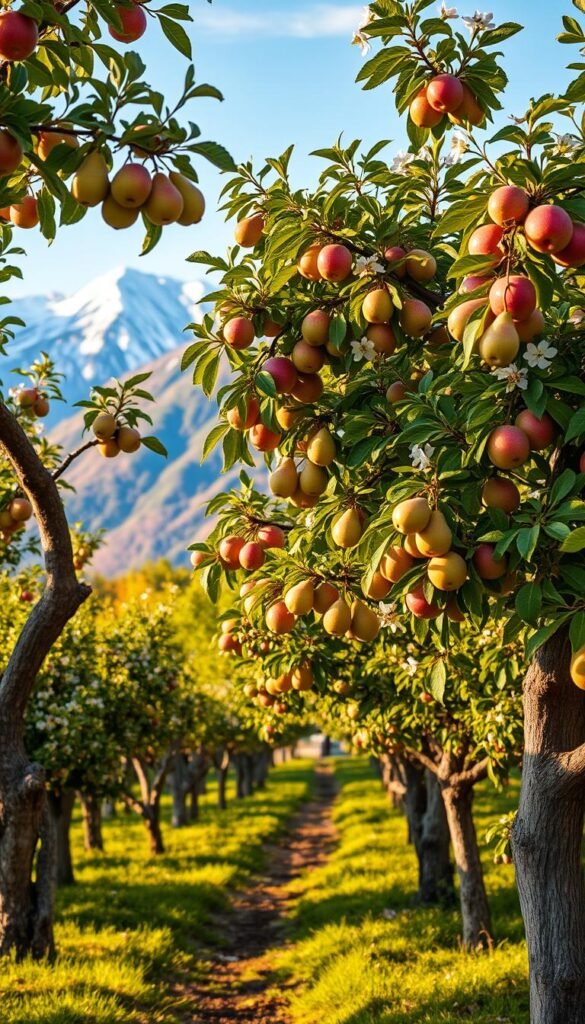
Northern growers face unique challenges, but modern varieties turn icy winters into sweet rewards. Discover resilient trees that produce bumper crops while shrugging off sub-zero temperatures.
Top Performers for Frigid Zones
Empire Apple trees deliver the crispness of Red Delicious with Macintosh’s tangy zing. These compact growers thrive in Zones 4-7, yielding reliable harvests even after -25°F winters. Their dense flesh resists bruising – perfect for fresh snacks or cider presses.
Honeycrisp steals the show with explosive juiciness and extreme cold tolerance. “You haven’t tasted real apples until you’ve grown these frost-defying marvels,” says Minnesota orchardist Lisa Tran. Zones 3-7 gardeners enjoy crackling-sweet fruits that store for months.
| Variety | Zone Range | Key Features | Best Use |
|---|---|---|---|
| Gravenstein Apple | 2-9 | Earliest producer | Sauces & baking |
| Romeo/Juliet Cherry | 4-7 | Self-pollinating pair | Fresh eating |
| Montmorency Cherry | 4-8 | Tart flavor profile | Pies & preserves |
Zone 2 warriors rejoice – Gravenstein apples handle -50°F snaps while producing aromatic fruits by late summer. Pair them with Romeo and Juliet dwarf cherries for space-saving pollination. These sweet-tart partners yield pint-sized harvests perfect for balcony gardens.
Montmorency remains the undisputed champion for bakers. Its bright red fruits develop richer flavor when temperatures dip, creating pie fillings that outshine store-bought cans. Choose zone-tested varieties rather than risking tender imports – your harvests will thank you.
Warm-Climate Fruit Trees for Southern Gardens
Southern landscapes come alive with sun-loving trees that turn summer heat into sweet rewards. These varieties soak up long growing seasons, delivering flavors you won’t find in grocery stores. Whether you’re near the Gulf Coast or in arid Southwest regions, there’s a perfect match for your exact conditions.
Citrus and Tropical Options
Meyer lemons brighten zones 9-11 with year-round harvests. Their thin-skinned fruits add zing to drinks and dishes. Pair them with Valencia oranges for classic juice varieties or Key limes for pie-ready tartness. “These citrus stars need just 6 hours of sun and well-drained soil,” notes Texas grower Marco Ruiz.
Figs thrive where others wilt. Brown Turkey and Celeste varieties pump out two harvests annually in zones 7-10. Their honeyed fruits taste best straight from the branch. For drought-resistant beauty, Wonderful pomegranates offer ruby-red arils and fiery orange blooms.
| Variety | Zones | Key Features | Harvest Period |
|---|---|---|---|
| Meyer Lemon | 9-11 | Everbearing | Year-round |
| Celeste Fig | 7-10 | Heat-tolerant | June & August |
| Angel Red Pomegranate | 7-11 | Seedless variety | September-November |
| Nam Doc Mai Mango | 10-11 | Sweet fiberless flesh | May-July |
Tropical lovers in frost-free zones 10-11 can grow creamy Nam Doc Mai mangoes. Red Lady papayas produce 15-pound fruits within 18 months. Container gardening extends possibilities—move potted guavas indoors when temps dip below 32°F.
These trees do more than bear fruits. They create shade canopies, boost property values, and attract pollinators. With smart selection, your yard becomes a edible oasis that laughs at summer’s worst heat.
Tips for Managing Early Spring Frost and Seasonal Challenges
Outsmarting late frosts is key to a bountiful growing season. Your local last spring frost date acts as nature’s calendar – miss this marker, and tender blooms might face icy ruin. Track this deadline like your harvest depends on it (because it does).
Watch for clear skies and calm winds – these often signal impending frost after sunset. When thermometers dip near freezing, drape breathable row covers over vulnerable trees. These fabrics trap ground heat while letting light through, shielding blooms without smothering them.
Not all trees need equal protection. Delicate peach flowers succumb to damage at 28°F, while apple buds withstand colder snaps. Prioritize shelter for early spring bloomers when unexpected freezes strike.
Smart timing beats constant vigilance. Remove covers by mid-morning to prevent overheating, and water soil before cold nights – moist earth stores warmth better. With these tricks, you’ll turn early spring weather worries into confident preparation.

